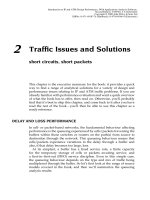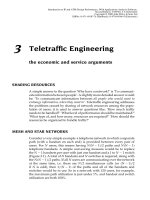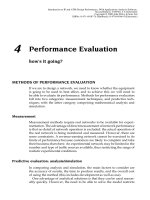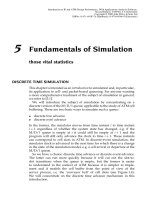Tài liệu Giới thiệu về IP và ATM - Thiết kế và hiệu suất P8 ppt
Bạn đang xem bản rút gọn của tài liệu. Xem và tải ngay bản đầy đủ của tài liệu tại đây (107.63 KB, 11 trang )
8
Cell-Scale Queueing
dealing with the jitters
CELL-SCALE QUEUEING
In Chapter 4 we considered a situation in which a large collection of CBR
voice sources all send their cells to a single buffer. We stated that it was
reasonably accurate under certain circumstances (when the number of
sources is large enough) to model the total cell-arrival process from all
the voice sources as a Poisson process.
Now a Poisson process is a single statistical model from which the
detailed information about the behaviour of the individual sources has
been lost, quite deliberately, in order to achieve simplicity. The process
features a random number (a batch) of arrivals per slot (see Figure 8.1)
where this batch can vary as 0, 1, 2,...,1.
So we could say that in, for example, slot n C 4, the process has
overloaded the queueing system because two cells have arrived – one
more than the buffer can transmit. Again, in slot n C 5 the buffer has
been overloaded by three cells in the slot. So the process provides short
periods during which its instantaneous arrival rate is greater than the cell
service rate; indeed, if this did not happen, there would be no need for a
buffer.
But what does this mean for our N CBRsources?Eachsourceisata
constant rate of 167 cell/s, so the cell rate will never individually exceed
the service rate of the buffer; and provided N ð 167 < 353 208 cell/s, the
total cell rate will not do so either. The maximum number of sources
is 353 208/167 D 2115 or, put another way, each source produces one
cell every 2115 time slots. However, the sources are not necessarily
arranged such that a cell from each one arrives in its own time slot;
indeed, although the probability is not high, all the sources could be
(accidentally) synchronized such that all the cells arrive in the same slot.
In fact, for our example of multiplexing 2115 CBR sources, it is possible
Introduction to IP and ATM Design Performance: With Applications Analysis Software,
Second Edition. J M Pitts, J A Schormans
Copyright © 2000 John Wiley & Sons Ltd
ISBNs: 0-471-49187-X (Hardback); 0-470-84166-4 (Electronic)
114
CELL-SCALE QUEUEING
0
1
2
3
4
5
nn+1 n+2 n+3 n+4 n+5 n+6 n+7 n+8 n+9 n+10
Time slot number
Number of arrivals in a slot
Figure 8.1. A Random Number of Arrivals per Time Slot
for any number of cells varying from 0 up to 2115 to arrive in the same
slot. The queueing behaviour which arises from this is called ‘cell-scale
queueing’.
MULTIPLEXING CONSTANT-BIT-RATE TRAFFIC
Let us now take a closer look at what happens when we have constant-bit-
rate traffic multiplexed together. Figure 8.2 shows, for a simple situation,
how repeating patterns develop in the arrival process – patterns which
depend on the relative phases of the sources.
Queue
size
(a) All streams out of phase
Figure 8.2. Repeating Patterns in the Size of the Queue when Constant-Bit-Rate
TrafficIsMultiplexed
ANALYSIS OF AN INFINITE QUEUE WITH MULTIPLEXED CBR INPUT: THE NÐD/D/1
115
Queue
size
Queue
size
(b) Two streams in phase
(c) All streams in phase
Figure 8.2. (continued)
It is clear from this picture that there are going to be circumstances
where a simple ‘classical’ queueing system like the M/D/1 will not
adequately model superposed CBR traffic; in particular, the arrival
process is not well modelled by a Poisson process when the number
of sources is small. At this point we need a fresh start with a new
approach to the analysis.
ANALYSIS OF AN INFINITE QUEUE WITH MULTIPLEXED CBR
INPUT: THE N·D/D/1
The NÐD/D/1 queue is a basic model for CBR traffic where the input
process comprises N independent periodic sources, each source with
thesameperiodD. If we take our collection of 1000 CBR sources, then
N D 1000, and D D 2115 time slots. The queueing analysis caters for
all possible repeating patterns and their effect on the queue size. The
buffer capacity is assumed to be infinite, and the cell loss probability is
approximated by the probability that the queue exceeds a certain size x,
116
CELL-SCALE QUEUEING
i.e. Qx. Details of the derivation can be found in [8.1].
CLP ³ Qx D
N
nDxC1
N!
n! Ð N n!
Ð
n x
D
n
Ð
1
n x
D
Nn
Ð
D N C x
D n C x
Let’s put some numbers in, and see how the cell loss varies with different
parameters and their values. The distribution of Qx for a fixed load of
0 10203040
Buffer capacity
10
−10
10
−9
10
−8
10
−7
10
−6
10
−5
10
−4
10
−3
10
−2
10
−1
10
0
Q(x)
N = 1000
N = 500
N = 200
N = 50
•
k:D 0.. 40
NDD1Q x, N,:D D
N
N
nDxC1
combin (N, n)Ð
n x
D
n
Ð
1
n x
D
Nn
Ð
D N C x
D n C x
x
k
:D k
y1
k
:D NDD1Q k, 1000, 0.95
y2
k
:D NDD1Q k, 500, 0.95
y3
k
:D NDD1Q k, 200, 0.95
y4
k
:D NDD1Q k, 50, 0.95
Figure 8.3. Results for the NÐD/D/1 Queue with a Load of 95%, and the Mathcad
Code to Generate (x, y) Values for Plotting the Graph
HEAVY-TRAFFIC APPROXIMATION FOR THE M/D/1 QUEUE
117
D N/D D 0.95 with numbers of sources ranging from 50 up to 1000 is
given in Figure 8.3. Note how the number of inputs (sources) has such
asignificant impact on the results. Remember that the trafficisperiodic,
and the utilization is less than 1, so the maximum number of arrivals
in any one period of the constant-bit-rate sources (as well as in any one
time slot) is limited to one from each source, i.e. N.ThevalueofN limits
the maximum size of the queue – if we provide N waiting spaces there
would be no loss at all.
The NÐD/D/1 result can be simplified when the applied trafficisclose
to the service rate; this is called a ‘heavy traffictheorem’.Butlet’s first
look at a useful heavy traffic result for a queueing system we already
know – the M/D/1.
HEAVY-TRAFFIC APPROXIMATION FOR THE M/D/1 QUEUE
An approximate analysis of the M/D/1 system produces the following
equation:
Qx D e
2ÐxÐ
1
Details of the derivation can be found in [8.2]. The result amounts to
approximating the queue length by an exponential distribution: Qx is
the probability that the queue size exceeds x,and is the utilization. At
first sight, this does not seem to be reasonable; the number in the queue
is always an integer, whereas the exponential distribution applies to a
continuous variable x;andalthoughx canvaryfromzerouptoinfinity,
we are using it to represent a finite buffer size. However, it does work:
Qx is a good approximation for the cell loss probability for a finite
buffer of size x. In later chapters we will develop equations for Qx for
discrete distributions.
For this equation to be accurate, the utilization must be high. Figure 8.4
shows how it compares with our exact analysis from Chapter 7, with
Poisson input traffic at different values of load. The approximate results
are shown as lines through the origin. It is apparent that although the
cell loss approximation safely overestimates at high utilization, it can
significantly underestimate when the utilization is low. But in spite of
this weakness, the major contribution that this analysis makes is to show
that there is a log–linear relationship between cell loss probability and
buffer capacity.
Whyisthisheavy-traffic approximation so useful? We can rearrange
the equation to specify any one variable in terms of the other two.
Recalling the conceptual framework of the traffic–capacity–performance
model from Chapter 3, we can see that the traffic is represented by
(the utilization), the capacity is x (the buffer size), and the performance









